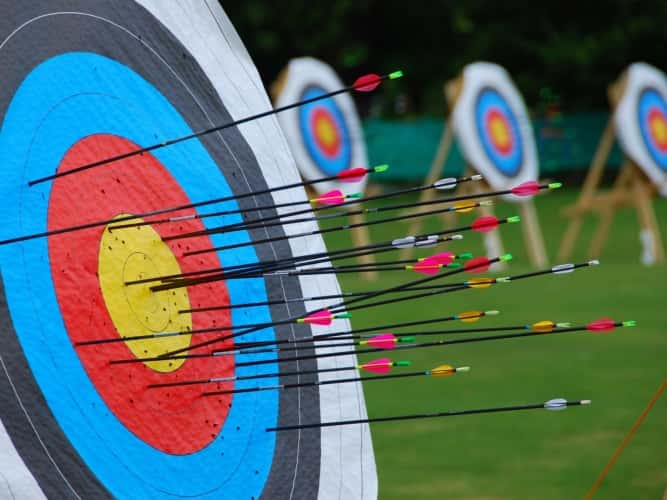(image borrowed from KBRX)
"Beside the point" is an ancient archery reference that literally means your shot was wider of the target. Figuratively, we mean it to be your argument is irrelevant. This part of the meaning came about in 1352, as did the phrase, "You missed the mark."
(image borrowed from Wikipedia)
A marathon race is exactly 26 miles and 385 yards long because in 1908 with the first modern Olympic marathon was designed to start at Windsor Castle and end at the royal box in the London stadium. Naturally, that distance was exactly 26 miles and 385 yards long. The race was to honor Pheidippedes who had run 22 miles, 1,470 yards to carry news to Athens that the Greeks had defeated the Persians on the plains of Marathon in 492 BC.
(image borrowed from Usher Gallery)
Ancient Greek athletes would've done well in the modern Olympic games. Their records stood firm until the 20th Century. Some examples of the records were Protiselaus who threw a discus 152 feet in a standing position. Clarence Houser, an American eventually beat the record by throwing the discus 155 feet in 1928. In 656 BC, Chionis, a Greek Olympian, made a long jump record by jumping 23 feet, 1.5 inches. His record was eventually beat in 1900 by American, Alvis Kraenzlein by jumping an extra 4.5 inches.
(image borrowed from The Tree Center)
The Greeks used laurels to represent their victory. Great warriors were crowned with a wreath of laurels after a victorious battle, the leaves were to represent their supreme status during the victory parade. Since the first Olympic games were consisting of war games, champions were honored in the same way. When it was said to "rest on your laurels" it was meant to quit while you were ahead.
(image borrowed from Harry Potter Wiki)
When the Greeks were victorious in the field of battle, they would come back home to build a monument that was dedicated to a specific god. They called this a "trophy." Gruesomely, these "trophies" were built from the limbs of the dead enemy soldiers and then it was hung on a tree or pillar. This ritual is still kept alive by modern "trophy hunters" who celebrate their victory by slaughtering unarmed animals.
The book then goes on to say, "be grateful for the Stanley Cup." I agree!
(image borrowed from KLCE.com)
The blue ribbon became a symbol for champions starting back in 1348. King Edward III of England created the highest Royal Order of the Knights of the Garter. The membership was limited and exclusive to the king and princes of England, and a very select few knights. Their given insignia was a blue garter and eventually this brought us to our blue ribbon given to the first place winner of a given contest.
That was an interesting bit of history!









I love reading these randoms. Keep 'em coming.
ReplyDeletesherry @ fundinmental
I'd always wondered about the weird distance of a marathon. Very interesting!
ReplyDeleteNicole @ Feed Your Fiction Addiction